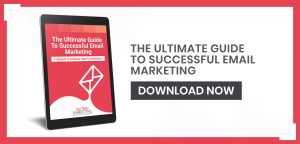Email Marketing Will Produce the Highest ROI: Here’s Why

Are you satisfied with the return on your email marketing ROI? Understanding your return on investment (ROI) is essential for deciding which marketing channels are the most effective for driving results. The ROI metric should be top-of-mind when conducting your marketing analysis and understanding the financial impacts of your investments.
Before you calculate your ROI, you need to pull together the right information. This includes quantifying the costs by campaign and by channel (e.g., email marketing, paid search, paid social, organic social, organic search). You also need to consider other expenses such as time and resources spent on these areas to measure an accurate picture of your ROI.
Want more marketing news? Subscribe to our free newsletter.
Calculating Your Email Marketing ROI
According to Campaign Monitor: the Return on investment (ROI) is a measure used to evaluate the efficiency and profitability of an investment. In this case, it is a measure of the profitability of email marketing.
Here’s the formula for calculating ROI:
Revenue – Cost of Spend / Cost of Spend = ROI (Expressed as a Percentage)
Calculating your ROI per campaign is the best way to make consistent cost comparisons and see how well your campaign is performing. We also recommend calculating your ROI by channel to compare results.
For example, we started working with a client to nurture and grow their email list to improve sales.
- We crafted a mix and match of emails for this technology client that were directed to high level business owners and executives.
- The second segment were to the managers or directors in IT, security, and compliance.
- Some emails were focused on webinars and driving attendees to our booth and speaking sessions at these events, while others were for nurturing inbound leads through a sequence of Awareness and Consideration emails to move them down the funnel to sales demos.
Let’s say you have a product that costs $1,000 to produce and sells for $10,000. You sell 6 of these products as a result of your email campaign efforts, so your total cost is $6,000 and your total sales is $60,000. Let’s say your email campaign costs are $1000, for a total cost of $7,000. Your ROI is:
($60,000 – $7,000) / $7,000
= $756 / $7,000
= 108%
In this example, you’re earning a 108% return on investment. For every $1 you spend, you get $10.81 back.
ROI of Other Channels
Social Media
Social media is an essential tool for brand presence in the marketplace. You have to build a strategy, set realistic goals, and put in the work to make it a viable channel for marketing. If you don’t have a strategy, you won’t see results.
The average social media marketing ROI heavily depends on six key factors:
- The type of business you run
- The industry you serve
- Your target market
- Setting realistic goals for the best channels to reach your specific market
- Doing the work and measuring the results
- Making improvements week after week
Social media can be a powerful tool for your business. If you can’t find the time to create content and be active online, you should consider outsourcing your social media.
The typical costs associated with social media marketing are the time and resources to make it happen, including curating content, purchasing a social media platform (Buffer, Hootsuite, Later, or HubSpot) for scheduling, monitoring and measuring the results.
But tracking your ROI may be difficult because it’s hard to quantify the exact amount of time and effort put into your posts. If you’d like an estimate of your social media ROI, check out this resource to help you compute a rough estimate of what you may be spending.
Video
Calculating your video ROI is similar to social media ROI in that it’s difficult to quantify due to the number of variables impacting the total value. Your video ROI costs typically include the time and resources to create video content for your marketing, leveraging video platforms like YouTube or Vimeo, and any costs associated with creation of video ads.
For example, it’s free to upload videos on YouTube, but you’ll need to purchase ads for your videos to expand your reach and lead generation efforts. The average YouTube ad costs between $0.10 to $0.30 per ad. ROI for video content includes the time and energy it takes to film, edit, and publish these videos across platforms. These costs can quickly add up but not receive the same reach or engagement as other methods such as organic search, paid ads, or organic social media.
Webinar
Webinars are another high conversion marketing tool to build your email list and generate new leads. Webinars are valuable assets to any company, whether it’s B2B or B2C. Rutkin Marketing has had success implementing webinars for both types of companies.
Producing the webinar is part of the ROI equation. The secret to success is following up with your leads AFTER the webinar. You need to create a high-performing funnel for the webinar to move leads down the funnel to sales.
The average ROI costs for a webinar include the time and resources to facilitate and promote them through all of your channels (email, social, etc.) plus any costs associated with the platforms (Zoom, Go to Webinar, BrightTalk, etc.). the amount spent on developing, reviewing, and releasing the content for your audience.
If you want to build quality leads, you have to host a killer webinar to get results.
Webinars convert 5-20% of viewers into buyers but do not always ensure that these buyers will become repeat customers or respond to future marketing campaigns. While webinars are successful for building relationships and sharing industry knowledge, it’s a time-consuming endeavor that might not result in the highest return on your investment if you don’t it right.
Paid Ads
Paid ads are an effective and quantifiable investment but are often more expensive than alternatives.
Google ads are an excellent way to generate awareness and leads. Google Ads is less invasive than other more traditional ads, and since they are targeted, there is a high conversion rate.
LinkedIn Ads are one of the top performing channels for B2B marketing. LinkedIn has highly active, engaged, and qualified leads ready to interact with your ads. There is a wide variety of business professionals engaging on LinkedIn every day, so you’re sure to find your target audience.
Whereas, the average Facebook cost per lead is $6.23 as of August 2022.
All and all, paid ads take time.
These campaigns may take longer to see a substantial return on investment because it depends on the channel you use to host your ads, the demographic seeing the ads, and the overall reach the ad gets and the frequency of those ads. We recommend running a campaign for at least six months to test different types of ads and offers to really get a handle on what works best to reach and convert your audience into leads and customers.
The success and return of paid ads depend on how many people it reaches. Paid ads require enough consumer information to be effective, such as cookies or search history, but may not come easily if your target market does not allow websites to access this information. Furthermore, the ad could reach your target, but it doesn’t ensure they have interest in your ad. Unless you’re very established and have had past success with past ads, the investment might not be worth your time.
People are flooded with ads daily, so much so that there is a term called “ad fatigue”. People may not even pay attention to your ads because they’re desensitized to all the ads they’ve seen before yours. This means that for your paid ads to be effective, you have to make them interesting, compelling, and personable to your target audience.
Email is the Highest ROI
Email marketing continues to rank among the highest in audience engagement. Email marketing ROI tends to be the most optimal marketers see. In fact, for every $1 invested in email marketing, marketers saw on average $42 in return.
According to HubSpot’s State of Inbound Marketing Report, “for a more holistic view, marketers should focus on the metrics that help them identify which content resonates, where email creative, copy or send frequency is falling flat, and potential signals to improve the entire customer journey.”
Here are the areas to focus your analysis:
- Measure the most impactful email campaigns and replicate what works.
- Monitor optimizations and monitor what drives clicks (and conversions).
- Consider how email influences other marketing channels’ and how your email analysis can drive more success.
Overall, the email marketing goals and conversions will still matter even if not every email results in a sale. You’ll gain insightful data from initial and continued lead and customer contact. Understanding the importance of calculating and tracking your marketing campaign ROI is vital for understanding the impact on your bottom line, the costs behind your efforts, and why a mix of marketing channels matters for your organizations success in converting leads to buyers. Email marketing is a high-return tool because it usually receives better audience engagement than any other channel.
Whether you’re looking to get started or brush up on your email marketing strategy, our Email Marketing Guide covers all your bases for converting contacts into customers. If you’re ready to do an email marketing assessment to see what’s working and how to improve your strategy, contact us for a Free 30-Minute Email Assessment to gain insight into how your marketing impacts your business and ROI. We’ll share examples that you can apply right away to improve your return on your email marketing efforts.
Getting Started is Easy
Rutkin Marketing is a HubSpot solutions partner and specializes in helping businesses of all sizes finetune their messaging, hone in on their marketing strategy, and grow their sales initiatives. The professional team at Rutkin Marketing can help you identify a strong selling strategy along with an execution plan and KPIs to measure your success in the platform you choose to use.


